19 Best Things to Do in Yogyakarta Besides the Temples (2024)
I am fully in love with Yogyakarta. Jogja, as it’s also called, has it all: culture, cuisine, religion, art, you name it.
The cherry on top came in late 2023 when UNESCO designated it as a heritage site for its Cosmological Axis – a straight line connecting Mount Merapi to the South Sea with deep spiritual significance to the Javanese people.
Yogyakarta is the city travelers stay at to visit Borobudur and Prambanan, the two most famous ancient and awe-inducing temples in Java. Mind you, there are over 20 temples in Yogyakarta you can easily visit.
This blog post however is focused on the things to do inside Yogyakarta. You should also check out these experiences around Yogyakarta.
Yogyakarta is part of my complete 14-day Java Backpacking Itinerary.
I lived in Jogja for 6 months and now I’ll share with you little-known places, authentic experiences, and insider tips.
Join me as I pour my heart out with this ultimate list of things to do in Yogyakarta for an extremely authentic trip!
Yogyakarta Fun Fact 1: Yogyakarta is the main city of Daerah Istimewa Yogyakarta, a Special Administrative Region, part of Indonesia. It’s the only region of the Republic still directly governed by a monarch.
Interesting Areas in Yogyakarta
These fun places to visit in Yogyakarta offer a nice insight into how locals actually live. This is the real Jogja with its quirky, cool, buzzing spirit.
1. Alun-alun Kidul
Alun-alun Kidul is the south public square of the two that surround the Kraton, aka the Walled Palace.
Kidul is the Javanese word for south, whereas Selatan is the Indonesian, thus it’s sometimes called Alun-alun Selatan. See these Indonesian phrases before your trip.
The Alun-alun is a 110m. by 110m. piece of flat grassland that used to be the grounds where the Sultan’s army exercised. Today it’s one of the most famous meeting and chill-out spots in Yogyakarta.

Things to do at Alun-alun Kidul:
- Do the Masangin Challenge: In the middle of the square are two massive banyan trees called Masangin. There’s a legend of a so-called Topo Bisu Ritual where soldiers lined up perfectly and walked between the trees. Thus, a tradition was born: Can you walk between the trees with your eyes closed? Rent a blindfold for 5.000 IDR (0.35$) and if you succeed, your wish will come true.
- Rent an Odong-odong: Rent one of the colorful neon mini-mini-buses and pedal around the alun-alun. The price to rent is around 50.000 IDR (3.5$).
- Color a cartoon: With the resurgence of coloring books for adults, you’d be surprised at just how many adults sit down at one of the small chairs around the alun-alun to color a page with a popular cartoon character. Markers and pencils provided. Price: 15.000 IDR (1$) and you can keep your creation.
- Eat all the snacks: You won’t be hungry at the alun-alun: there are over 100 street food stands and vendors surrounding the square.

2. Prawirotaman Street Art
Prawirotaman is a notable street in Jogja, famous for its backpacker’s accommodation options (sometimes called “bule area“, bule meaning foreigner), availability of western food like pizza and burgers (by the way, please don’t eat that, check out my authentic places to eat in Yogyakarta suggestions instead), and not the least – street art.
Chances are you might already be staying around Jalan Prawirotaman, so take a stroll before sunset around the area to explore the graffiti, murals, and funky cafes that make Jogja so quirky.

3. Kampungs
I absolutely adore kampungs.
A kampung is an Indonesian neighborhood, usually characterized by small alleys, colorful houses, a tightly-knit community, warungs with awesome home-cooked meals, kids flying kites, and their older brothers training pigeons.
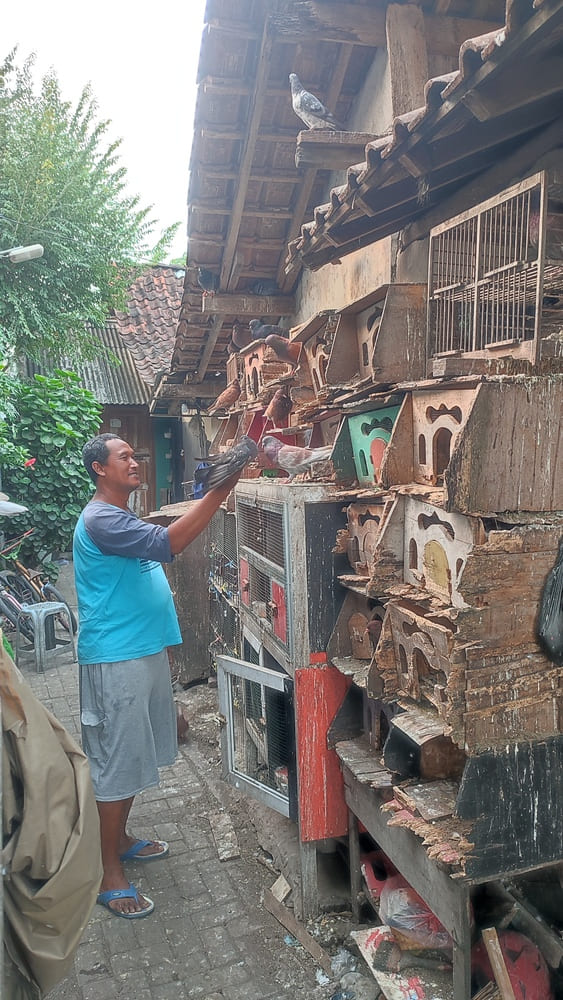
You must take a walk inside at least one kampung while in Jogja!
Beware: you might get lost! (Joking! Or am I?)
Pro tip: When you pass by locals in kampungs, wave or bow and say “Monggo“, which is the Javanese greeting towards older people. Then watch the locals light up and cheerfully greet you back with “Monggo, monggo!“
Some of my favorite kampungs in Yogyakarta are:
- Ngampilan: especially the area between the streets KH. Ahmad Dahlan and Karel Sasuit Tubun. MAP.
- The river between the kampungs Suryatmajan and Tegal Panggung: This is the Code River, just 5 minutes east of Malioboro. You’ll immediately feel the contrast between the hustle and bustle of the city and the peace and quiet of the kampung.
- Purwokinanti: Another awesome kampung with cute small alleys. While strolling, find the legendary Rujak Es Krim Pak Paino and have an authentic Yogyakartan dessert.
- The river between Pakuncen and Ngampilan: This is the Winongo River, around 20 minutes west of Malioboro. If you’re noticing a trend, it’s that the alleys and pathways next to rivers in Jogja are a wonderful place to escape the noise of the busy streets.

Museums in Yogyakarta
There are countless museums in Yogyakarta and here I’ll tell you about the ones that are most worth a visit.
4. Keraton Ngayogyakarta Hadiningrat (Sultan’s Palace)
The Kraton was built in the 18th century and is still used as a residence by the Sultan himself – Sri Sultan Hamengkubuwono X!
Nonetheless, the Kraton is open for visitors as a museum where you can see a great collection of royal artifacts, an array of horse carriages used by the Sultans, and watch a traditional arts performance.
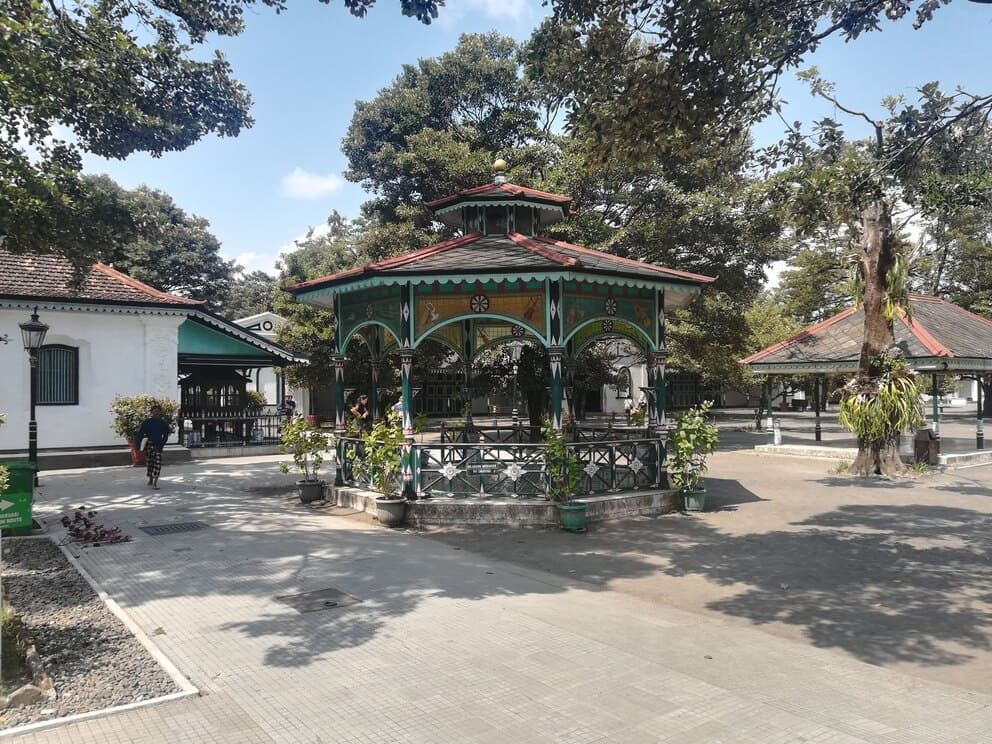
The shows are different every day (except Monday when the Kraton is closed) and do not cost extra to watch. Here’s the schedule:
- Tuesday: Gamelan (traditional Javanese music) at 10:00;
- Wednesday and Saturday: Wayang Kulit (Javanese Puppet Show) at 9:00;
- Thursday and Sunday: Javanese dances at 9:00;
- Friday: Macapat (Javanese poetry and songs) at 10:00;
The entrance ticket to the Yogyakarta Kraton is 15.000 IDR (1$) for foreigners.
The Kraton is open Tuesday to Sunday from 8:00 to 14:00.
Yogyakarta Fun Fact 2: The Sultan does indeed live inside the Kraton. He employs over 1000 people from nearby kampungs to do a variety of tasks.
5. Sonobudoyo Museum
While the Kraton houses a lot of artifacts, most Javanese heritage is displayed in the Sonobudoyo Museum, right outside the main Kraton entrance.
The museum has a vast collection from ancient times to the present day. It’s split into two units – old and new.
The ticket costs only 20.000 IDR (1.35$) giving you access to both. Sonobudoyo is open from 8:00 to 21:00 every day except Monday.
6. Taman Sari, the Water Castle
Taman Sari literally translates to “beautiful flower garden“.
It features many pools of water, artificial lakes, a bathing complex, and a few water pavilions leading a Dutch researcher to call it “Waterkasteel“, i.e. “Water Palace/Castle” in his article. The name stuck with backpackers.
The Taman Sari complex consists of 18 water gardens, over 50 buildings, a unique underground mosque (Sumur Gumuling), and many nice places to relax or take pictures.
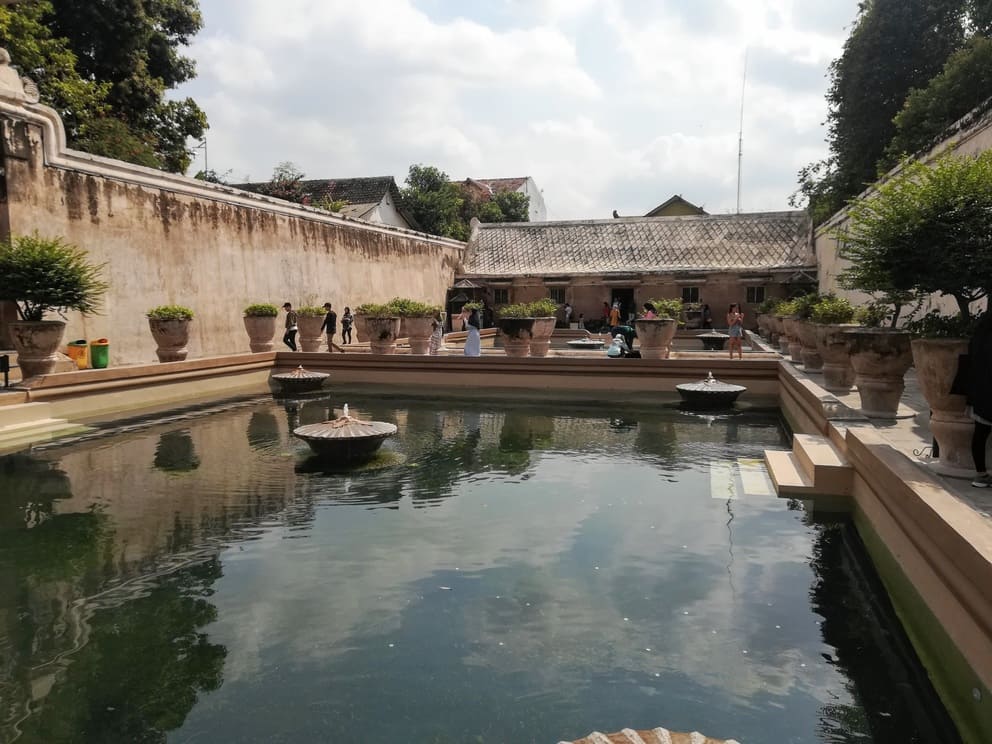
What you would see today is largely the result of renovations in the 1970s and yet most of the complex is in a very bad state.
Regardless, it’s still rather easy to imagine how the Sultan walked around the bathing area to pick a concubine for the day.
Taman Sari is open every day from 9:00 to 15:00. Ticket is 15.000 IDR / 1$ for foreigners.
7. Fort Vredeburg
As a person obsessed with 20th-century history, the museum at Fort Vredeburg tops my list of things to do in Yogyakarta.
With its 4 halls of dioramas, the museum covers the Indonesian Struggle for Independence from 1945 to 1949. There’s plenty of information in English and it’s all ordered chronologically.
As the name suggests, it used to be a Dutch Fort until 1947. A similar fort called Fort Vastenburg exists in nearby Surakarta, although it’s not a museum.

Fort Vredeburg is open Tuesday to Sunday from 8:00 to 15:00. The entrance ticket for foreigners costs 10.000 IDR (0.7$).
Yogyakarta Fun Fact 3: Yogyakarta was the capital of Indonesia between 1946 and 1948 after Jakarta was captured by the Dutch.
8. History Of Java Museum (HOJM)
If you want to wrap the history of Yogyakarta up from pre-Islamic times to the modern day, then the History Of Java Museum is the best place to go.
Upon entering, a guide will accompany you around the museum explaining things as you go. You can linger in places you find interesting and there’s a ton of information in English.
Additionally, there’s an Augmented Reality option inside the museum. All you need to do is download and install the app beforehand (History of Java Museum AR) and the staff will explain how to use it there.
To get to the museum, take bus #8 from Malioboro to Jalan Parangtritis, then walk a little to the museum.
The museum is open from Tuesday to Sunday, 9:00 to 18:00. Entrance ticket: 35.000 IDR / 2.35$.
Markets, Shopping Streets & Quirky Stores
Yogyakarta is famous for its shopping opportunities. Indonesians from all across Java (and beyond) travel to explore the stores and markets in Jogja.
Even if you’re not interested in buying anything, the places I have lined up here offer a very interesting cultural experience.
9. Malioboro
Jalan Malioboro has become synonymous with Yogyakarta over the years. If the Kraton is the heart, Malioboro is the aorta.
Here’s something that nobody would tell you though: that’s not even the name of the street!
Its official name is “Jalan Jenderal Ahman Yani“, while Malioboro is the name of the neighborhood around the street.
Malioboro is 1.3 km long, divided into 4 sections with over a thousand stores lined up on both sides of the street. There are also street performances, buskers, department stores, street food stands, malls, traditional markets, hotels, mosques, museums and so much more.
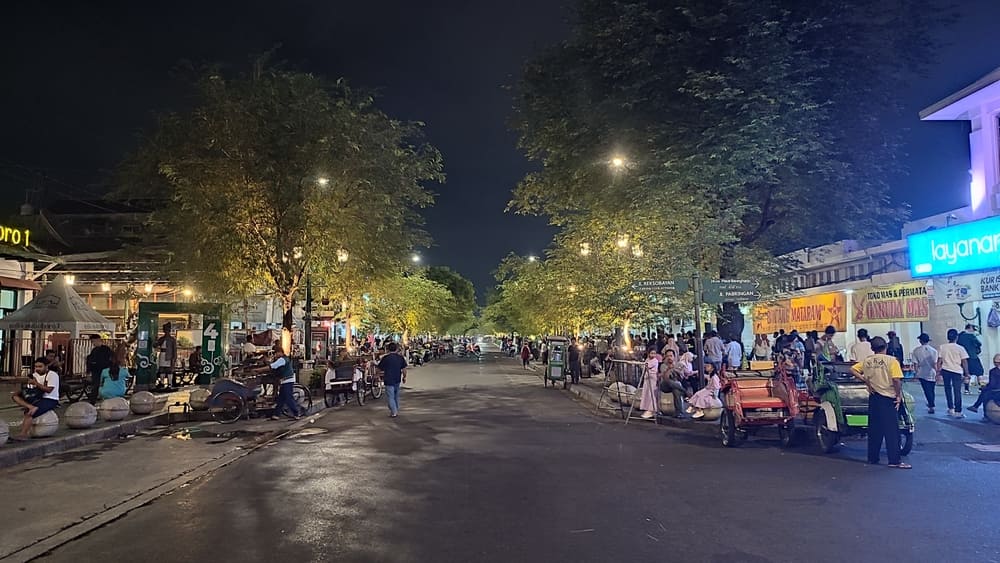
Malioboro is closed for traffic between 18:00 and 21:00 every day when only horse-drawn carriages (called Andong) and occasional bicycles are allowed on the street.
There are plans to make it entirely pedestrian, especially now that Malioboro is part of the UNESCO-recognized Cosmological Axis of Yogyakarta.
At the southern end of Malioboro is Kilometer Nol, i.e. the Zero Point of Yogyakarta and a popular pre-wedding photo spot for couples.
Yogyakarta Fun Fact 4: The straight line between the Kraton and Mount Merapi runs along Malioboro.
In other words, starting at Alun-alun Kidul and going straight north, one passes through the Kraton, Kilometer Nol, Malioboro, Tugu Monument, and 30 km. later – the crater of Mt. Merapi.
That’s the Cosmological Axis of Yogyakarta now part of UNESCO.
10. Pasar Beringharjo
At the southern end of Malioboro, you’ll find one of the biggest markets in Yogyakarta and maybe Indonesia too.
Pasar Beringharjo has been operating continuously since 1758! It’s packed with vendors on 3 floors, selling everything from batik and lingerie to fruits and nuts to antiques. It’s reminiscent of the very similar Klewer Market in Surakarta (Solo).
However, what you see today is a building in Art Deco style from the 1930s.
Even if you don’t intend to do any shopping, Pasar Beringharjo is an interesting place to visit.
And if you’re traveling in Indonesia during the rainy season (October to March), Beringharjo is a perfect place to wait out the afternoon downpour!
Pasar Sore
Right next to Beringharjo, you will find the evening outdoor market for all things clothes. Don’t forget to haggle!
Flea Market
Behind Pasar Sore, on the right side of Pasar Beringharjo is the flea market. It opens every day around sunset and continues until around 23:00. As with other flea markets, you can find anything and everything there.
Try to strike jackpot by finding a rare Dutch Indies coin from the 1930s.
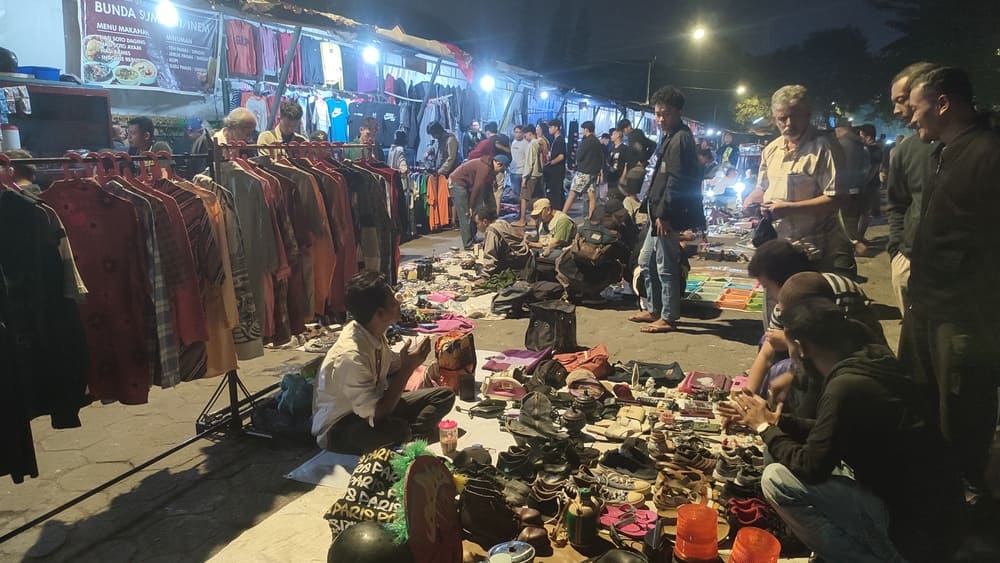
11. Hamzah Batik
Opposite Beringharjo is one of the most famous stores in Yogyakarta – Hamzah Batik.
As the name suggests, it offers an almost overwhelming choice of batik clothing, but also thousands upon thousands of souvenirs, trinkets, artistic creations, paintings, snacks, toys, books, and so much more.
Prices in Hamzah Batik are fixed, so no haggling here. It’s open every day from 19:00 to 24:00.
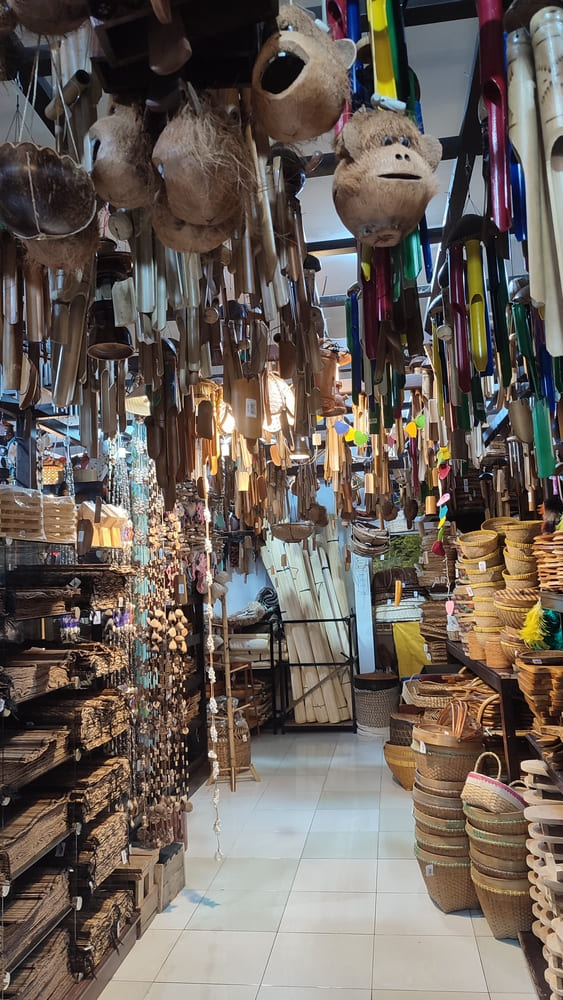
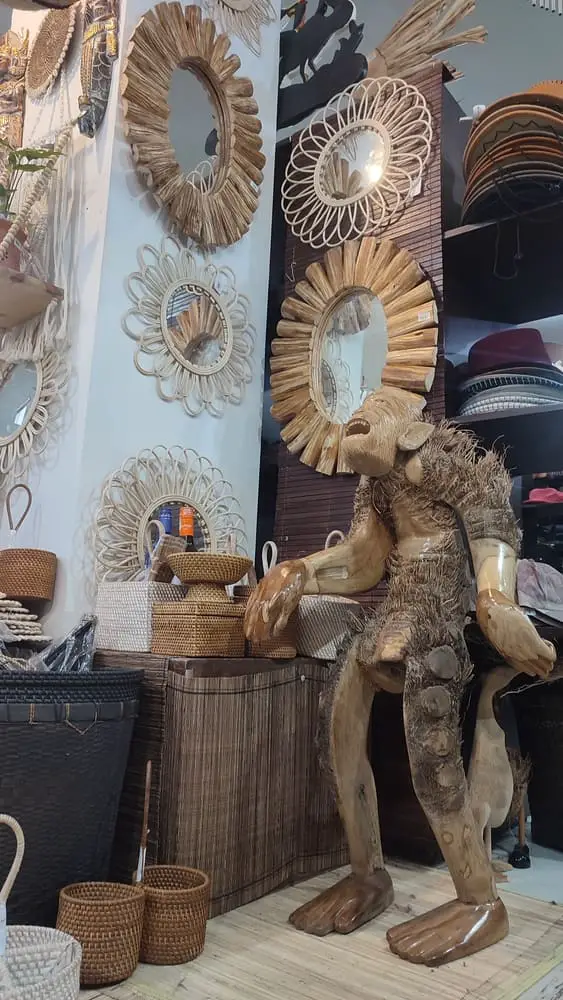
12. Pasar Ngasem
Moving on to more traditional markets, Pasar Ngasem is a lovely small market situated just north of Taman Sari. Vendors there sell fruits and vegetables, meat, homeware, and street food.
My advice: go there in the morning for a delicious breakfast of carabikang (sweet rice cakes).
13. Kranggan Traditional Market
Kranggan Market is very close to Tugu Monument, thus walking distance away from the north end of Malioboro.
Spread on two levels you can find fruits, vegetables, clothes, and of course traditional Indonesian food. It’s a little more authentic than Ngasem because it’s not next to a big and popular tourist attraction like Taman Sari.
14. Pasar Serangan
If you’re into even more authentic market experiences, Pasar Serangan is definitely off the beaten track. This is the real Indonesian market!
While living in Jogja, I frequently went there to buy fruits like mango, papaya, pomelo, oranges, grapes, rose apples, watermelon, etc.
Make sure you try the martabak manis (sweet thick pancake) that at least 2 vendors inside prepare on the spot for you. Here’s a list of Indonesian desserts to try too.

Yogyakarta Fun Fact 5: The Indonesian Hero Prince Diponegoro who fought against the Dutch colonizers in the Java war (1825-1830) was born in Yogyakarta as the son of Sultan Hamengkubuwono III.
You can visit his hiding place in Goa Selarong, just 10 km from the center of Jogja.
Religious places to visit in Yogyakarta
Yogyakarta is very religious. Islam plays a big role in the life of people here and Jogjans pride themselves as pious descendants of the first Islamic political entity on Java – the Mataram Sultanate.
Check out these religious sites in Yogyakarta:
15. Masjid Gedhe Kauman
The Great Mosque of Yogyakarta can be found just outside of the Kraton, west of the north Alun-alun. Masjid Gedhe has been the Sultan’s Mosque since the time of the first Sultan of Yogyakarta – Hamengkubuwono I, who oversaw its establishment in 1773.
The Mosque follows the Javanese architectural style for religious buildings. Its triple-tiered roof is visible from afar. The serambi (roofed veranda) in front is a staple in Javanese architecture.
It is the most beautiful mosque in Jogja.
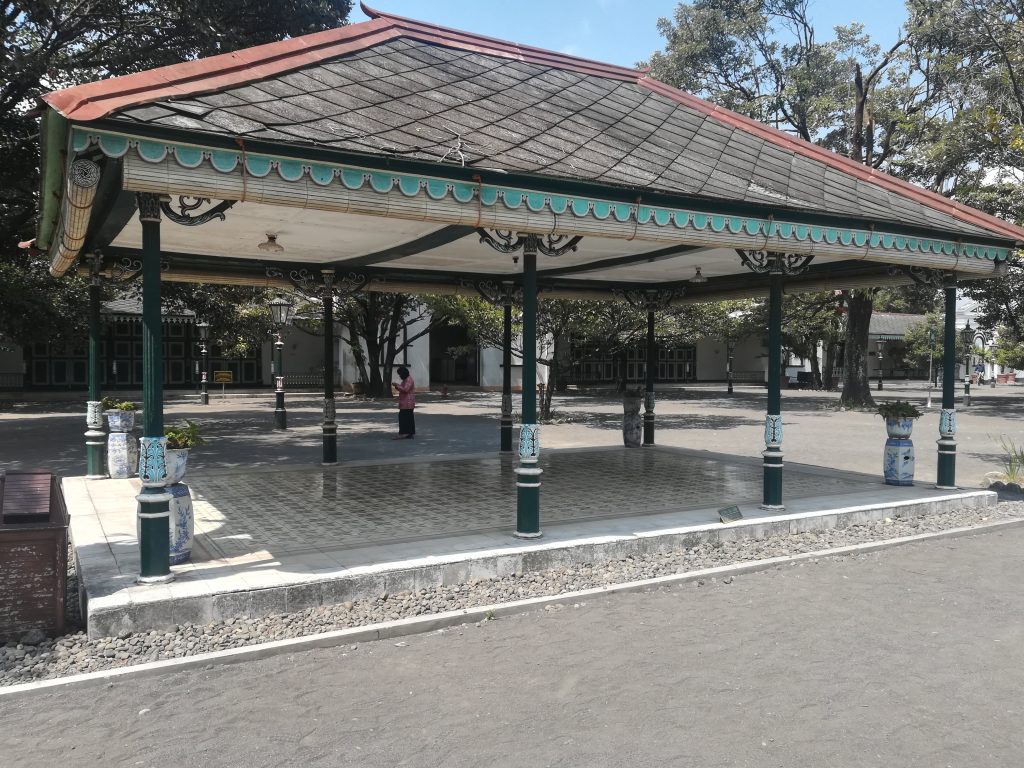
16. Jogokariyan Mosque
Close to Prawirotaman, you can see the bright-blue Jogokaryan Mosque. The mosque is beautiful on its own, but the reason I’m including it on this list of unique things to do in Yogyakarta is because of its original operations.
The mosque is 100% non-profit, as mosques should be, but given its popularity, the amount of money given to charities and community projects is simply outstanding. Moreover, the outstanding balance of the mosque must be 0 at the end of every single week!
You can enter and get acquainted with the number of community projects the mosque maintains.
17. Masjid Gedhe Mataram Kotagede
Before the Yogyakarta Sultanate and Surakarta Sunanate split in 1755, they were united in what used to be the Mataram Sultanate. The first capital of Mataram was Kotagede (Great City), now a small suburb of Yogyakarta.
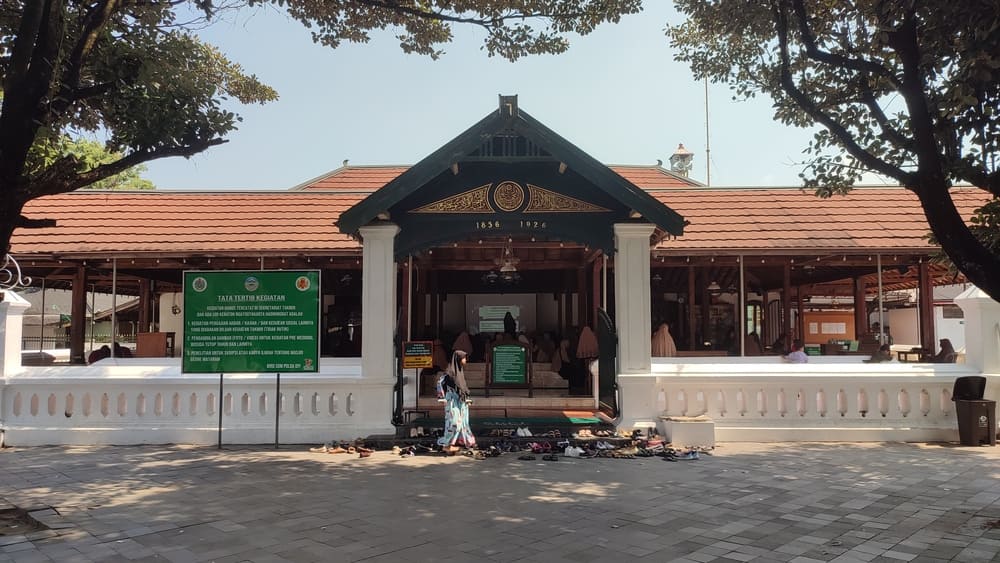
In Kotagede, the first Muslim Rulers built Masjid Gedhe which still stands today. The place is deeply spiritual and carries an air of mysticism.
The royal cemetery (Makam Mataram) of the first sultans of Mataram is also there. To enter the cemetery, you must rent a Javanese sarong and headwear from the stand outside.
During his reign, Sultan Agung III of Mataram built a new Royal Cemetery about 14 km south of Kota Gede near Imogiri. Read here how to visit the Imogiri Royal Cemetery on a day trip from Yogyakarta.
The area of the Mosque, Cemetery, and Royal Baths is well-preserved and there are Hindu symbols on some of the walls. Locals believe that the spirits of the past Sultans still linger in the area. Boooo, spooky.
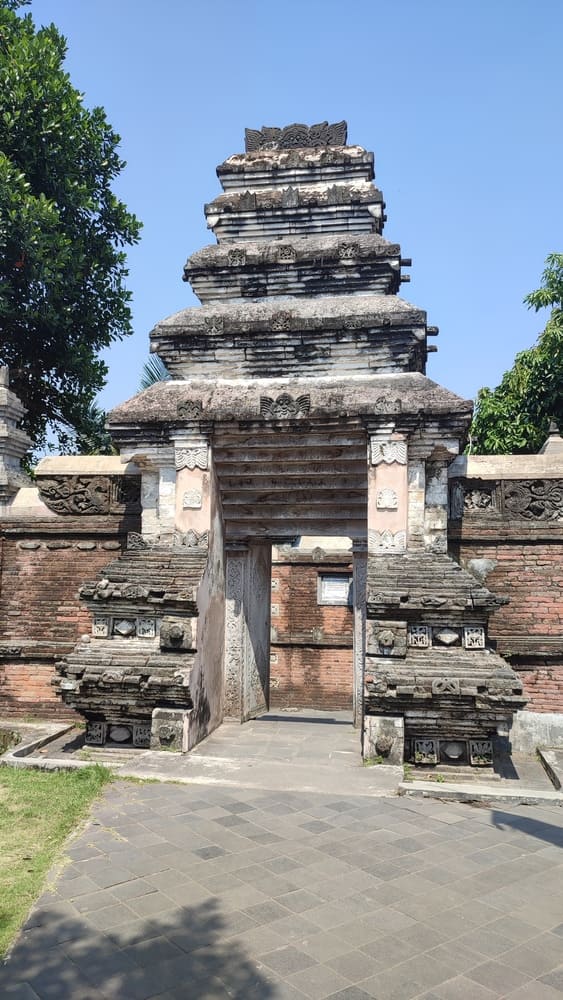
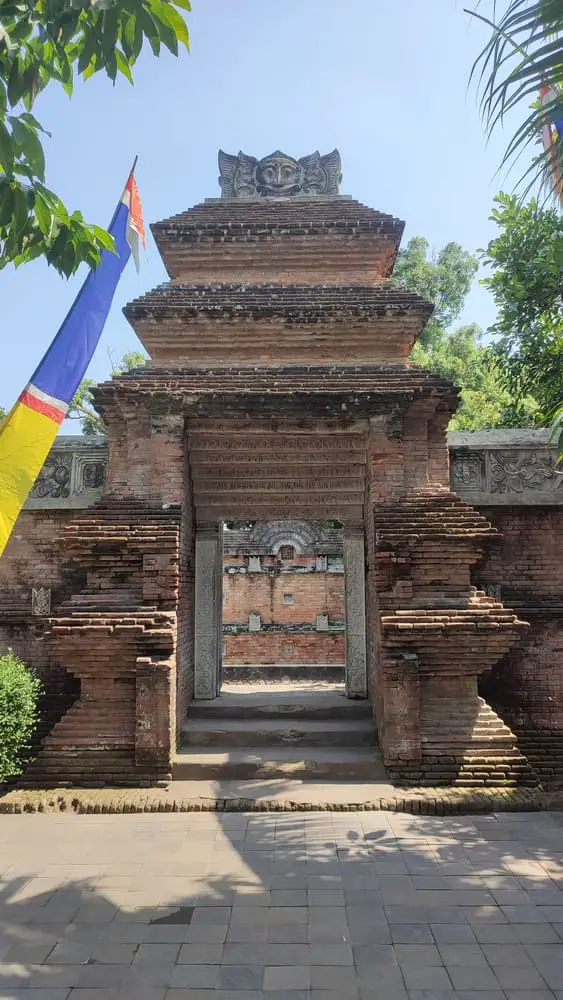
To get to Kotagede, take bus K2J or bus #3A from Malioboro, then walk a little bit.
Yogyakarta Fun Fact 6: Yogyakarta has the nickname The City of Education for the numerous universities in the city, the most notable being Gajah Mada University. 20% of all Yogyakarta residents are students!
Other things to do in Yogyakarta
Here are some notable places to visit in Yogyakarta that don’t fit into the categories so far.
18. Gembira Loka Zoo
Yogyakarta’s Zoo is not world-famous, however, it still boasts a wide array of animals to admire. Primates, reptiles, birds, and even elephants and penguins. You name it, it’s there in Gembira Loka.
The entrance ticket is 60.000 (4$) from Monday to Friday and 75.000 IDR (5$) on the weekend. The Zoo is open every day from 8:00 to 16:00.
There’s a free shuttle bus inside and an option to go on a speedboat ride too.
19. Rumah Hantu Malioboro
Did you know that Javanese people strongly believe in ghosts and spirits in stark contrast with the rules of Islam?
That’s right, according to Javanese traditions, the spirits of the dead wander around us. Some are benevolent, some malicious, and some outright taken out of a horror movie.
If you want to see how the Javanese imagine these ghosts, check out Rumah Hantu on Malioboro Street. It’s a bit of a tourist trap to be completely honest, but it’s not the worst thing ever considering it’s only 35.000 IDR (2.35$) to enter.
How to Get to Yogyakarta
Yogyakarta Airports
Yogyakarta has an international airport with the code YIA, located some 40 km from the city center. A train line connects YIA with Yogyakarta Tugu Train Station (the central one).
It’s about every hour and costs only 20.000 IDR (1.35$) whereas the bus takes longer, and costs more (80.000 IDR / 5.35$).
Yogyakarta International Airport has daily flights to and from Jakarta and Bali (domestic), and Kuala Lumpur and Singapore (International).
There’s also another airport called Adisudjipto with code JOG which is technically International, but almost exclusively serves domestic flights. I’ve found flights from Adisudjipto Airport to be more expensive than from Yogyakarta International.
Yogyakarta Railway Stations
There are two railway stations in Yogyakarta: Tugu and Lempuyangan. They are very close to one another, but you have to be careful which one your train departs from, because most trains stop only at one of the stations, rarely at both.
Yogyakarta has direct daily trains to Jakarta, Surabaya, and Banyuwangi (for the ferry to Bali).
Here’s my guide to traveling between Yogyakarta and Bali.
And this is my guide to trains from Jakarta to Yogyakarta.
Check and book tickets online at Kereta Api Indonesia.
By Bus
Train transport trumps buses on Java big time, so I don’t recommend using buses to travel to Yogyakarta. If you have to, there are two main terminals in Yogyakarta:
- Terminal Giwangan in the southeast part of the city has buses to farther destinations on Java like Jakarta and Surabaya;
- Terminal Jombor has buses to nearer destinations like Magelang (for Borobudur).
How to travel within Yogyakarta City
Yogyakarta is a relatively small city and you can easily walk to all main attractions.
Public Transport inside Jogjakarta
There’s a public transport network called TransJogja with buses crossing the city in all directions. All routes are uploaded to Google Maps, but timetables are unreliable.
Tickets are 3600 IDR (0.24$) purchasable at bus stops (halte) or inside the bus.
Taxi Apps
There are three main taxi apps in Indonesia: GoJek, Grab, and Maxim.
Maxim is the newest and the parent company is Russian, so I avoid using them.
I’ve found GoJek to have lower prices for motorcycle rides and Grab to have lower prices for car rides.
The average cost is around 8.000 IDR/km for a motorcycle and 15.000 IDR/km for a car.
Andong (horse-drawn carriage)
You’ll see andongs around Malioboro. They are mostly for a fun way to go around the area at night, but you can still get from point A to point B with them if need be.
Note that it’s rather pricey to take andongs for transportation – a short trip usually costs around 50.000 IDR / 3.4$.
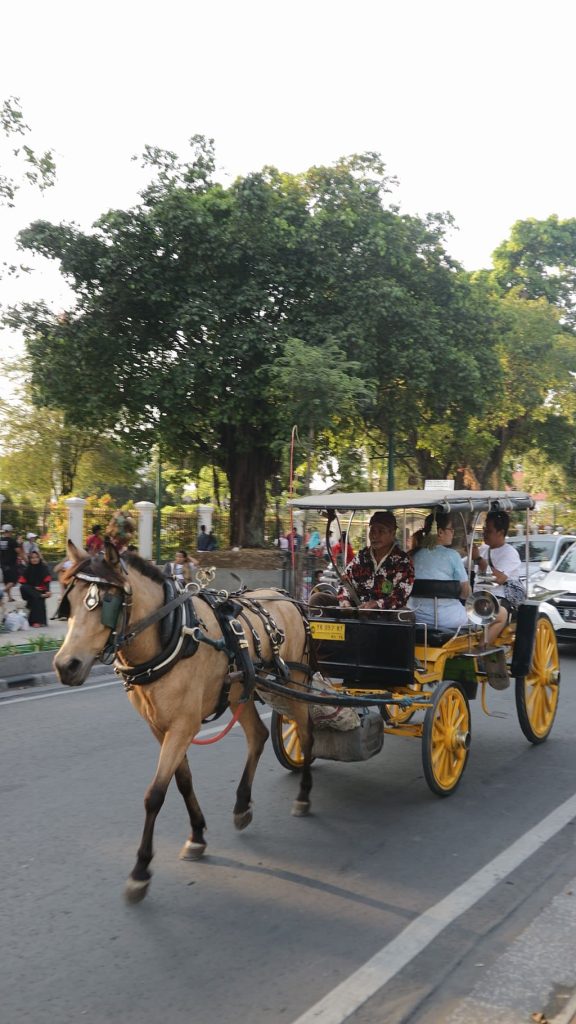
Becak (pedicab)
Becaks are popular with locals. If you want to support real local Jogjans, take a becak – you can’t miss them at Malioboro, they will probably offer their services before you even ask.
A short ride costs 10.000 to 20.000 IDR (0.7 to 1.4$).
If you don’t need a ride, simply say “Bouten pa“, which means “no thanks, sir” in Javanese.
Rent a motorcycle
If you want greater mobility and freedom and plan on exploring further than Jogja Kota on day trips and whatnot, why not rent a motorcycle?
You don’t have a license? Eh, almost nobody does anyway and police is way less common than in Bali or Thailand. After more than 100 hours on the road, I am yet to see a single policeman.
The best place to rent a motorcycle is in front of Lempuyangan Station. Expect to pay 80.000 to 150.000 IDR (6 to 10$) for a scooter per day.
Message (+62 823 3022 8307) on WhatsApp for the best motorcycle rental that I always use in Yogyakarta. Say you found the number from Simon to get a special offer.
Where to stay in Yogyakarta
Backpackers in Yogyakarta usually stay around Malioboro or Prawirotaman. Both areas have a wide array of accommodation options from cheap hostels to luxury hotels. Here’s my selection:
Yogyakarta has such an enormous pool of hostels, that it might be hard to choose. I’ve stayed in many and all of them are quite good.
My award for the best hostel, considering price and coziness goes to Arjuna Garden Homestay.
Do you want a private room, but not a high-end hotel? Then choose Snooze: a superb guesthouse, just meters away from the Kraton.
Do you want to splurge? Grand Zuri Malioboro is the best option to have a relaxing and luxurious stay in Yogyakarta.

